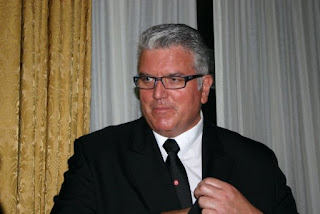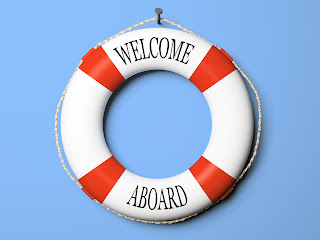
Today Amver attended the first day of the
Institute for Defense and Government Advancement Maritime Homeland Security Summit in Jacksonville, FL. There are easily 300 delegates in attendance which, considering the economy, is a strong showing. There is a good mix of Coast Guard, Homeland Security partners, and industry folks participating.
Don't worry.
Amver is not considering allowing intelligence or security services access to Amver vessel data. Most of these services understand the unique nature of Amver.
The conference started with remarks by USCG Captain Paul Thomas, Commander of
Sector Jacksonville, who you may remember from a previous Amver case involving the reunion of a survivor and the ship that rescued him. That story can be found
here.
USCG Vice Admiral Robert Papp,
Atlantic Area Commander, gave the USCG priorities for maritime homeland security followed by
USCG Rear Admiral Steve Branham,
Seventh District Commander, who gave an excellent overview of maritime threats, immigration, and drug trafficking operations in the Caribbean. The last speaker was retired US Navy Admiral
Harry Ulrich who gave an inspiring presentation, sans PowerPoint slides, and asked the question "What do you do?" Admiral Ulrich boiled things down to one simple statement which resonated with the delegates. "People want to use our infrastructure to do harm to us from the sea", he emphatically stated.
The remainder of the day saw topics such as programs for enhancing maritime domain awareness, implementing small vessel security strategies, inter agency coordination, and a dramatic presentation from Greg Flessate of
Orbcomm on tracking AIS data from space.
After a poolside lunch the topics continued including a discussion on the changing Arctic landscape, USCG capabilities update by
Rear Admiral Wayne Justice, and other breakout sessions.
We are looking forward to day two and will post an update at the close of the conference.
The one take away that sticks in our mind was a statement by Admiral Ulrich who said maritime governance will take priority over maritime domain awareness. It's one thing to know what is happening in the maritime domain, it's another to have the tools, laws, treaties, and policy to deal with that awareness. Great point.
What do you think? Are we putting all of our eggs in one basket? Is the world too focused on security? Tell us your maritime concerns.
 Is your company a US flagged shipping company? If so, your vessels likely earned Amver participation awards. In the past Amver hosted an awards ceremony in New York City. While we haven't hosted an awards ceremony in several years we are proud to announce the return of the US Amver Awards ceremony. This year the awards ceremony will be held at the National Press Club in Washington, DC on May 21, 2009 starting at 5:00 pm.
Is your company a US flagged shipping company? If so, your vessels likely earned Amver participation awards. In the past Amver hosted an awards ceremony in New York City. While we haven't hosted an awards ceremony in several years we are proud to announce the return of the US Amver Awards ceremony. This year the awards ceremony will be held at the National Press Club in Washington, DC on May 21, 2009 starting at 5:00 pm.














